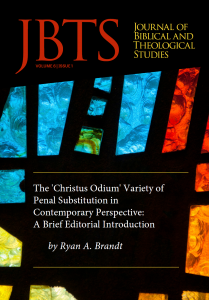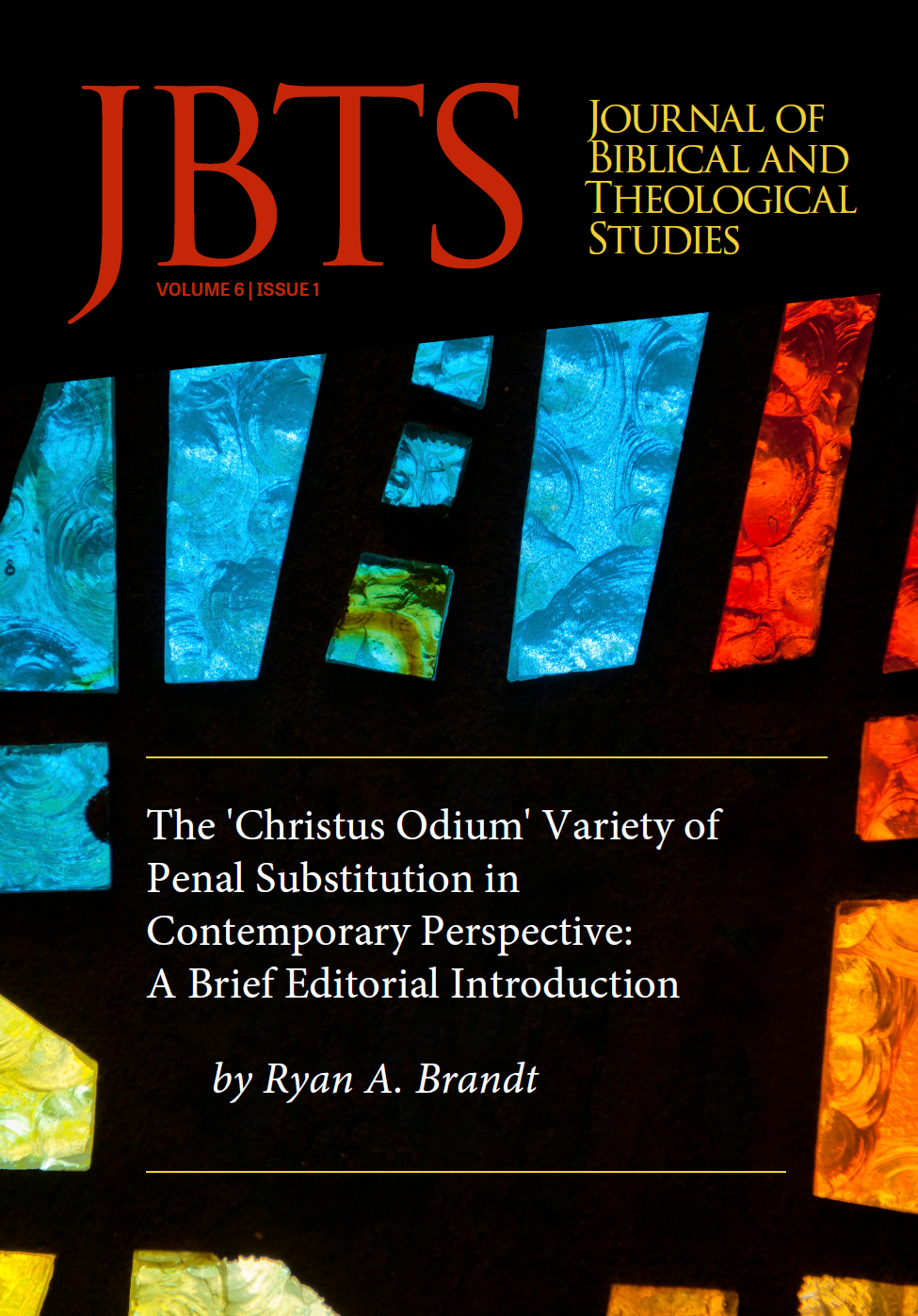Ryan A. Brandt
Managing Editor; Associate Professor of Christian History and Theology
at Grand Canyon University
Joshua R. Farris and S. Mark Hamilton have recently argued that the “Christus Odium” variety of penal substitution is an inappropriate model of the atonement both according to Scripture and theological reasoning.[1] They define their specific objection: “in some evangelical quarters, it is no longer enough to simply believe that Christ absorbed the wrath of God as a penal substitute. Some have recently gone so far as to claim that, as a penal substitute, Christ became the object of the Father’s perfect hatred.”[2] Farris and Hamilton, among other things, object to the notion that Jesus, the Son of God, was or ever could be hated by the Father. They term this view the “Christus Odium” view, which is a stronger variation of penal substitution view. As the editor of the journal that published Farris’s and Hamilton’s original article, I asked Owen Strachan (a member of our editorial board) if he would be interested in responding to their article, believing that this interaction would stir an interesting and productive conversation. Sometime thereafter we decided that this theological issue would make an excellent conversation at the annual meeting of the Evangelical Theological Society. The session included papers from Farris/Hamilton and Strachan, along with Thomas McCall, Derek Rishmawy, and Ryan L. Rippee.
As a result of this dialogue and exchange, JBTS is now publishing this symposium of papers, with added contributions from Ty Kiesler. This symposium includes papers that cautiously push back against some aspects of Farris and Hamilton’s argument (Rishmawy and Kiesler); others that explore the nature of the Father-Son relationship in the penal substitutionary atonement, both denying that the Father hated the Son at any point (Strachan and Rippee); Farris and Hamilton also provide a follow-up paper articulating more problems with the “Christus Odium” view. These papers and the larger conversation that this session provided make a significant contribution to the recent discussions about the validity of the penal substitution view of the atonement more broadly and the Christus Odium variety of penal substitution more narrowly. The topic also closely intersects with a myriad of issues related to fundamental doctrines of the Christian faith, most prominently the Trinity, Christology, sin, humanity, and (of course) the atonement. The extensive and complex nature of this discussion is one of the reasons that theological reasoning in this area is so tricky.
The specific questions raised in this symposium are ones that need to be addressed for the sake of clarity and—we hope—sufficient unity in Christian doctrine by both students and scholars. Some of the most pressing and controversial questions include the following: What exactly did the Son of God, Jesus Christ, bear on the cross? Was it God’s wrath? Was it specifically the Father’s wrath? If it was God’s wrath, then how can we express this notion without compromising the ecumenical and orthodox understanding of the Trinity and Chalcedonian theology? If it was the Father’s wrath, then what becomes of the classical conception of the Trinity and various analogues of the doctrine, such as the inseparable operations of the Triune persons? Was there a “break” or “disruption” at that moment in time between the Father and the Son? If so, how do we express this “break” or “disruption” precisely? If the Son of God did not experience God’s wrath on the cross, then how should we understand Jesus’s cry of dereliction? And more broadly, how exactly does Jesus atone for our sins?
There are several possible answers and constructive solutions that might be made to the above questions. As a brief introduction, just a few possibilities to two of these questions will be addressed here. Regarding the question of whether or not the Son was the object of the Father’s wrath, one might offer three possible answers: perhaps the Son was indeed the object of the Father’s wrath; or perhaps instead he was the object of God’s wrath, which includes his own wrath as the Son. Or alternatively, Jesus, in virtue of being the true and righteous human, having fulfilled the law, satisfied God and so the wrath of God upon him is no longer necessary. Jesus in each of these cases could be said to “satisfy” or “appease” the wrath of God: in the first two options, he satisfies or appeases the wrath of God by experiencing it and absorbing it; in the third option, one could say he satisfies or appeases the wrath of God in the sense that wrath no longer needs to be expressed to Jesus, since he is the true, righteous human. In this third option, this appeasement does not mean the Son actually experiences the wrath of God; rather, it means he satisfied it so it is no longer needed to be expressed towards him (and towards all those in him) as the righteous one.
Moving onto a related second question, if Jesus did indeed experience the wrath of the Father on the cross, did he also experience the Father’s hatred or derision? One could respond affirmably or not. In the former case, the Father’s wrath and hatred are seen as going hand-in-hand; in other words, because he experienced the wrath of the Father on this account, he also experienced his hatred. A proponent of this view might use Jesus’s cry of dereliction as evidence (“My God, my God, why have you forsaken me?” Ps 22:1), taking God here to refer specifically to the Father. In the latter case, one could argue that while Jesus was the object of the Father’s wrath, he was not the object of the Father’s hatred. Depending upon one’s definitions, a distinction could be made. A proponent of this view might use Jesus’ affirmation that the Father loves of him in his death (“For this reason the Father loves me, because I lay down my life that I may take it up again,” John 10:17), also pointing out that his cry of dereliction is not directed at the Father but the Godhead more broadly (“My God, my God”), of which he is the second person. So, again, one could say that Jesus experienced the wrath of the Father (i.e., the punishment; bodily death), but not the Father’s hatred. These possible answers are merely a beginning to this conversation, of course. There are other ways to address these questions and construct particular answers.
From this brief introduction, it is clear that these theological questions and potential solutions—like any theological doctrine—require careful definitions of terms (such as “forsakenness,” “hatred,” and “wrath”), precise attention to what the Bible means, and systematic, consistent thinking across adjacent doctrinal formulations (especially, the Trinity). As such, each article in this symposium approaches the topic in a unique way. There was no required methodology for papers nor a required list of issues to which to respond, since there are countless ways to do so. Each of the following papers, therefore, stands alone as a unique contribution. As far as the ordering of papers, as the moderator of the session, I decided to order this symposium in a similar way that the ETS session was ordered:
- Joshua R. Farris and S. Mark Hamilton, “Which Penalty? Whose Atonement? Revisiting Christus Odium”
- Derek Rishmawy, “A Less Odious Atonement Requires a More Classical God: Engaging Farris and Hamilton on Christus Odium”
- Owen Strachan, “It Was the Will of the Father to Crush Him: The Day of Atonement and the Cross of Christ”
- Ryan L. Rippee, “The Father’s Love for the Son in Penal Substitutionary Atonement”
- Ty Kiesler, “Performing the Surgery, Saving the Patient: Reduplication, Proper Christological Predication, and Critiques of Christus Odium”
I would like to thank all the contributors for an engaging and thoughtful dialogue on this subject. It was a pleasure to organize and moderate this event and symposium. I hope that our readers find it helpful as they reflect on the meaning of the atonement and its interaction within other theological loci.
[1] Joshua R. Farris and S. Mark Hamilton, “This is My Beloved Son, Whom I Hate? A Critique of the Christus Odium Variant of Penal Substitution,” JBTS 3.2 (2018): 271-86.
[2] Ibid., 271.





